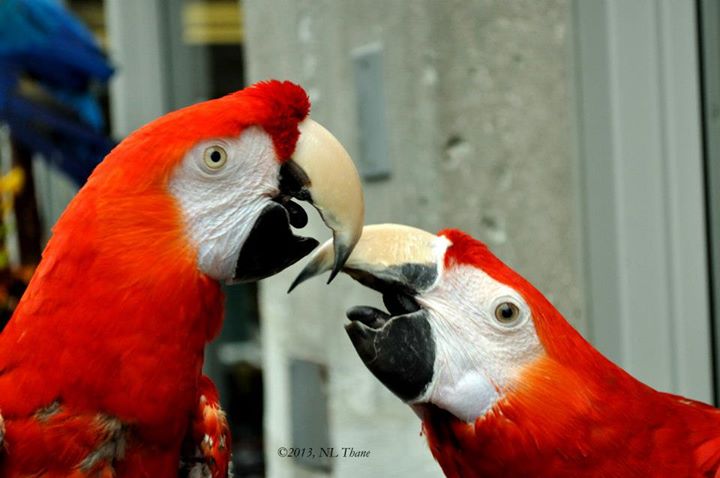WHEN FERTILE MYRTLE NEEDS A BREAK
Discouraging Breeding Behavior In Pet Birds
(Source: www.forthebirdsdvm.com)General Information
In the wild, female parrots will not lay eggs unless they have a mate and a suitable nesting site. In captivity, however, some parrots will lay eggs or even have repeated clutches of eggs despite the absence of a mate. Egg production is stressful for birds; it depletes their nutritional stores, and predisposes them to malnutrition, osteoporosis, and life-threatening illnesses. In situations where birds are being intentionally bred, these risks are an inherent part of the breeding process. For pet birds that are not being bred, however, egg laying can pose serious health risks without the benefit of producing chicks.Some birds have problems from the very first time they try to lay eggs. Other birds can lay for years before they run into difficulties. In either situation, however, reproductive problems can lead to eggbinding, oviductal prolapse, peritonitis, and death.
Unlike with cats and dogs, it is not a simple procedure to spay a bird. For many birds, the most effective way to stop egg laying is through environmental and behavioral changes. Some birds may also require medical intervention.
10 things you can do at home to stop your bird from laying eggs
1. Put your bird to bed early, by 5 or 6:00 p.m. A long day length is one of the most important environmental cues triggering egg laying in birds. By allowing your bird to stay up late, you are mimicking the long days of spring/summer, making your bird think it is time to breed. An early bedtime will help to turn off her breeding hormones. Note that she will need complete darkness and quiet for this to be effective (covering the cage while the radio or TV is on is not adequate!).

2. Keep your bird away from dark, enclosed spaces. Most parrots are cavity nesters, which means that instead of building a nest out in the open they look for dark, enclosed spaces in which to lay their eggs. In order to stop your bird from laying eggs it is essential that she is kept away from such areas. Nest boxes should be promptly removed. Birds can be ingenious when looking for a nesting site (under a couch, behind the microwave, even in the dryer!), so it is important that she is under close supervision when out of the cage.
3. Keep your bird away from other birds to which she is bonded. Having a mate is a strong stimulus for your bird to lay. This mate may be a member of the opposite sex, another female bird, or even a bird of a different species. Separating your bird from the other birds in your household will help turn off her hormones.

4. Discourage breeding behavior in your bird. Some birds will display breeding behaviors with their favorite person, such as vent-rubbing, tail lifting, or regurgitating food. Discourage these behaviors by putting your bird back in her cage for a “time out” whenever she displays them. Don’t pet your bird on her back or under her tail, as this can be sexually stimulating.
5. Remove your bird’s “love-toys”. Some single birds will display mating behaviors with objects in their environment, such as food cups, toys, perches, or mirrors. Mating behaviors include regurgitating food, vent rubbing, and tail lifting. If your bird engages in these behaviors with an inanimate object, that object should be permanently removed from her environment.
6. Rearrange the cage interior and change the cage location. Your bird is more likely to lay eggs in a cage that hasn’t changed in a while. Putting your bird in a different cage and/or changing the cage location can help discourage laying. Changing the arrangement or types of toys, dishes, and perches in the cage can also be very helpful.
7. Give your bird optimal nutrition and provide full spectrum light. Producing and laying eggs robs your bird of the vitamins, proteins, and calcium she needs to stay healthy. It is especially crucial during the breeding season that she is on a complete and balanced diet, which in most cases will be a pelleted diet. A seed diet supplemented with vitamins is not adequate. Ask your veterinarian to recommend a pelleted diet for your bird. Full spectrum sunlight is necessary for your bird’s calcium metabolism, and can be provided by unfiltered sunlight or by a full spectrum flourescent bulb.
8. Avoid removing the eggs which your bird has already laid. Sometimes the easiest way to turn off the egg-laying cycle is to allow your bird to sit on her eggs. If your bird lays a few eggs and then sits on them, leave the eggs in the cage for 21 days or until she loses interest. If however she does not stop at 3 – 4 eggs and continues laying, this strategy may not work, and you should call your avian veterinarian for further suggestions.
9. Ask your veterinarian about hormone injections. In certain cases of excessive egg-laying, your veterinarian may recommend hormone injections in addition to the above environmental and dietary changes. Hormone injections are relatively safe and can help reduce egg-laying in some birds. The effectiveness of hormone injections varies from bird to bird and can not be accurately predicted beforehand.
10. When in doubt, ask your avian veterinarian. If you have questions or concerns regarding your bird’s health, or if the above changes do not stop your bird from laying, please give them a call.